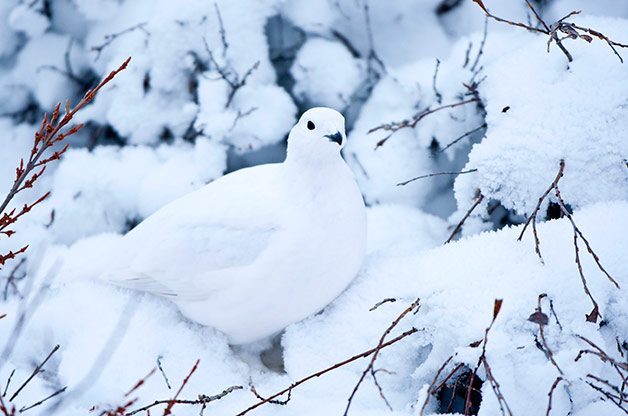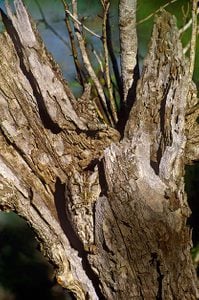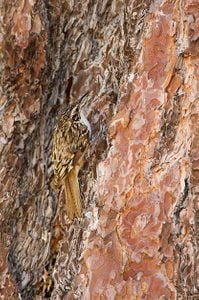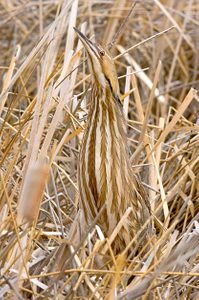Birding Basics to Camouflaged Birds
Updated: Apr. 24, 2020

Many camouflaged birds blend in with the background for their own survival—but you can spot them with the birding basics of how and where to look.
By necessity, birds are experts at camouflage. There are clear exceptions, like bright red male cardinals, but the rule is that birds thrive best when they’re least noticeable. Nesting females are a good example: They are often dull in color so they blend in with their surroundings during the vulnerable nesting season. Another well-camouflaged bird is the goldfinch in winter; it molts into drab plumage so it’s harder to see, even on bare branches.
But many birds are masters of disguise for all or most of the year, making them both a challenge and a thrill to discover. Here are a few cleverly hidden camouflaged birds you will want to watch out for, along with some tips on how to spot them.
Ptarmigan
One obvious benefit of camouflage is that it helps birds to hide from their enemies. Ptarmigan (including the willow, rock and white-tailed) are the champions of avian camouflage. Like chameleons matching their surroundings, ptarmigan molt with the seasons to evade predators. Mottled with warm browns during the summer and nearly completely white in the winter, ptarmigan change throughout the year. In the spring and fall, these chickenlike birds are dappled brown and white to mirror vegetation in transition.
Tip: One trick to spotting camouflaged birds is knowing their habitat. Look for ptarmigan walking low to the ground.

Owls
Camouflage helps hide predators from potential prey, as well as from smaller birds that tend to harass these hunters. Most owls have heavy streaking and mottling to break up their silhouettes. At times it’s nearly impossible to make out the shape of a great horned owl perched with its back against a tree trunk, or the outline of a snowy owl on the tundra. But the best camouflaged of these birds I’ve ever encountered was a screech-owl. I had found a small owl pellet, but I couldn’t spot the bird for the life of me. Finally, some scolding chickadees alerted me to the owl’s location: sitting in a clump of leaves, fully exposed on a slim branch.
Tip:For most owls, search the trees. Look for them close to the trunks; they usually don’t venture very far out on the limbs.
American Bittern
Heavily streaked plumage protects it well, but the American bittern has a trick that makes it even harder to spot in its marshy habitat. Bitterns will stick their bills up in the air to mimic surrounding reeds. They’ll even sway back and forth, doing a convincing cattail impression. I’ve been staring right at a bittern and then suddenly lost sight of it. Bitterns move slowly and deliberately through the marsh, stalking fish, frogs and other small prey.
Tip: If you want to see bitterns, it’s best to be patient and keep an eye out for even the smallest movement in a marsh.
Ducks
The flamboyantly patterned harlequin duck seems as if it would stick out—until you try searching for one along the tumbling rapids of a stream where the birds nest. Female ducks of different species can pose tricky identification challenges, because they’re so similarly patterned in brown scalloped feathers. While most males are dressed to impress during the breeding season, they tend to molt into brown feathers for a period, too. Ducks are some of the only species that molt all their flight feathers at the same time. Being able to hide along the edges of lakes and ponds is especially critical, since they can’t fly from danger for several weeks.
Tip: Want to spot a harlequin duck? Your best bet is to find one wintering along the northern ocean coasts or Great Lakes. Look for them standing along the rocky shores.
Creepers

Brown creepers have always looked to me like mice spiraling up the sides of tree trunks. They’re similar to nuthatches but have gray-brown plumage that blends in perfectly with bark. Once I saw one napping on the side of a tree; the outline of the body was barely visible, but the posture of the bird caught my eye. Another fun fact: Creepers will sometimes tuck their nests behind sections of loose bark. A bird with similar habits is the black-and-white warbler, which can be just as difficult to spot against tree bark.
Tip: Creepers start low and work their way up a tree. So if you think you spot one, wait for it to fly, then follow it up the tree with your binoculars.
Nightjars
With their tapered bodies and oddly shaped heads, the nighthawks, whip-poor-wills and their relatives sometimes don’t even look like birds to me. They’ll perch and nest on the ground, on a tree branch, or sometimes even on the roof of a building. Even if you can spot their feathers, you may still have a hard time telling where the head is. Part of the reason is that nightjars have a cryptic pattern that breaks up their outline, allowing them to blend in nicely with the background.
Tip:This is a tough one to offer a tip on. Keep your eyes on the ground, and make friends with local birders so they can help you find a nightjar when it’s been sighted. There’s strength in numbers!
Woodcocks
Although not related to nightjars, woodcocks are similar in many ways. They rely so heavily on remaining unseen that they’ll often sit tight rather than flying away, especially when incubating eggs. Like some of their shorebird relatives, woodcocks have long bills for probing. Sometimes they tuck their head down low, so the bill doesn’t give them away as they wait for a potential predator to move along.
Tip: Find a woodcock walk in your area. Or go on your own during spring, right around dusk, when these birds perform their famous “dance” by suddenly zooming up into the air.
Sometimes birds make themselves highly visible, singing from the treetops, soaring through the sky or swimming gracefully. At other times, even the prettiest and most colorful birds can be difficult to see. The next time you have to do a double-take to spot one, take a moment to appreciate its natural camouflage in action.

MORE TIPS ON CAMOUFLAGED BIRDS
Watch for Those Young ’uns
Juveniles are naturally vulnerable. Still learning how to fly and inexperienced at detecting predators, most birds wear drab plumage when they first fledge from the nest to increase their chance of survival. Some, like robins, waxwings and even sparrows, also benefit from spots or streaks that help conceal their shape.
If you think you spot a creeper, wait for it to fly, then follow it with your binoculars
Counter-what?
The term is countershading. It refers to the coloration of birds with darker backs and lighter bellies, like northern mockingbirds, eastern kingbirds and even shorebirds and gulls. This is another form of camouflage: From a distance, the dark back appears paler, while the paler belly appears darker, making the birds more difficult to spot.
Photo: Francis and Janice Bergquist
